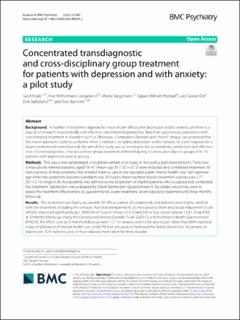| dc.description.abstract | Background: A number of treatment approaches have shown efficacy for depression and/or anxiety, yet there is a paucity of research on potentially cost-effective concentrated approaches. Based on our previous experience with concentrated treatment in disorders such as Obsessive–Compulsive Disorder and chronic fatigue, we proposed that this novel approach could be useful for other conditions, including depression and/or anxiety. As a pre-requisite for a future randomized controlled trial, the aim of this study was to investigate the acceptability, satisfaction and effectiveness of a transdiagnostic, interdisciplinary group treatment delivered during 5 consecutive days to groups of 6–10 patients with depression and/or anxiety.
Methods: This was a non-randomized clinical intervention pilot study in line with a published protocol. Forty-two consecutively referred patients, aged 19–47 (mean age 31.7, SD = 8.12) were included and completed treatment. All had a severity of their problems that entitled them to care in the specialist public mental health care. Self-reported age when the symptoms became a problem was 20.9 years. Mean number of prior treatment courses was 2.77 (SD = 2.19; range 0–8). Acceptability was defined as the proportion of eligible patients who accepted and completed the treatment. Satisfaction was evaluated by Client Satisfaction Questionnaire-8. Secondary objectives were to assess the treatment effectiveness by questionnaires at pre-treatment, seven days post-treatment and three months follow-up.
Results: The treatment was highly acceptable (91.3% accepted, all completed), and patients were highly satisfied with the treatment, including the amount. Functional impairment, as measured by Work and Social Adjustment Scale (WSAS) improved significantly (p < .0005) from “severe” (mean 25.4 SD = 6.59) to “less severe” (mean 13.37, SD = 9.43) at 3 months follow-up. Using the Generalized Anxiety Disorder Scale (GAD-7) and the Patient Health Questionnaire (PHQ-9), the effect sizes at 3 months follow-up were 1.21 for anxiety and 1.3 for depression. More than 80% reported reduced utilization of mental health care, and 67% had not used, or had used the family doctor less, for anxiety or depression. 52% had not used, or had reduced, medication for their disorder.
Conclusions: The concentrated, interdisciplinary treatment approach yielded promising results. Long-term follow up is warranted. | en_US |

